DN17 and DN18 turn 30 and 31 days old today! The dynamic duo are tracking and paying attention to life outside the nest: the place that their parents come from and go to, often bearing food, and the world that their parents see, hear, and respond to: birds overhead, animals on the ground, other eagles, one another. It’s a wonderful look at the ways in which instinct and imprinting unlock an important behavior and all the learning that goes with it.
Play is an important part of learning and we’ve seen a lot of it: nibbling and moving nesting materials, tossing nestovers around (bones make excellent toys!), and playing with siblings. Wingercizing is also taking off as the dynamic duo get better at standing and coordination! They aren’t yet ready for the wingercizing Olympics, but it shouldn’t be long. Pinfeathers are unfurling, feather cloaks are filling in, and plushy tushy tailfeathers are peeking out, although their flight feathers will only be about 80% of their eventual length when they leave the nest. Flight feathers are longest in juvenile eagles, making them look extremely large. If you see a giant brown eagle near water in the Midwest during the summer months, it’s a juvenile eagle. It’s hard to overstate how large they look!
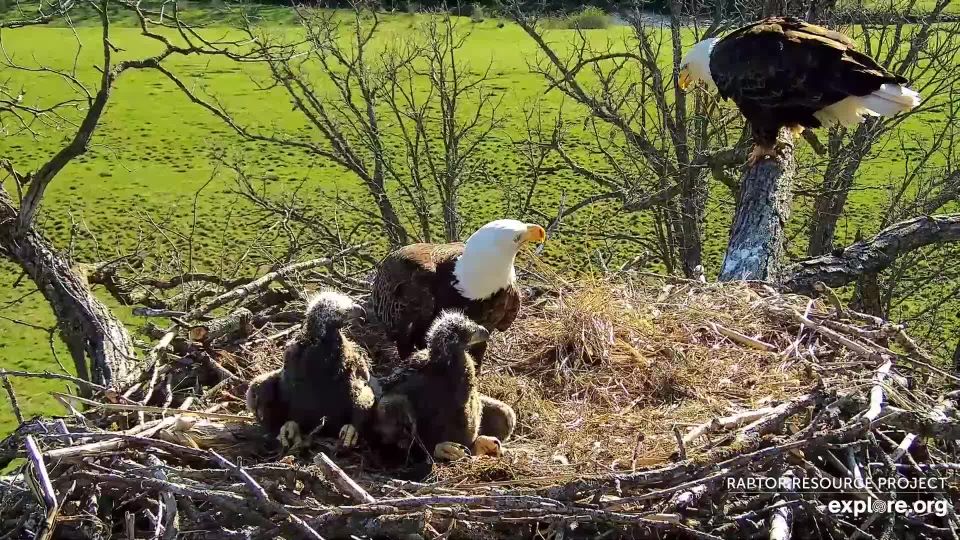 April 24, 2024: Family portrait: DN17, Mr. North, DN18, DNF
April 24, 2024: Family portrait: DN17, Mr. North, DN18, DNF
Mr. North and DNF are feeding fewer times on average, although the eaglets are eating much larger meals and all the inedible bits that come with them, including an opossum’s mandible. It’s hard to believe that the peaglets’ growth is about to begin slowing given their insatiable appetites. Feather growth and muscular development are taking over from tissue growth and weight gain: a big and important second month change as they begin unlocking, learning, and practicing the skills they will need for life outside the nest. Enjoy now – we have 40 or 50 days to watch them before they fledge!
Decorah Eagles
April 24, 2024: DN17: Warble, PS, & a Walk-a-thon clear across the nest – https://youtu.be/qGQHoeYoqK0?si=hGOtCD2JN6dltwSj. Look out below! The eaglets have moved from hitting the cribrails and ladder branch to shooting poop straight out of the nest. After relieving itself, DN17 goes on a walk-a-thon across the nest, moving slowly but well as it negotiates the nest on its clown clompers. Look for emerging plushy-tushy tailfeathers at the end of the video.
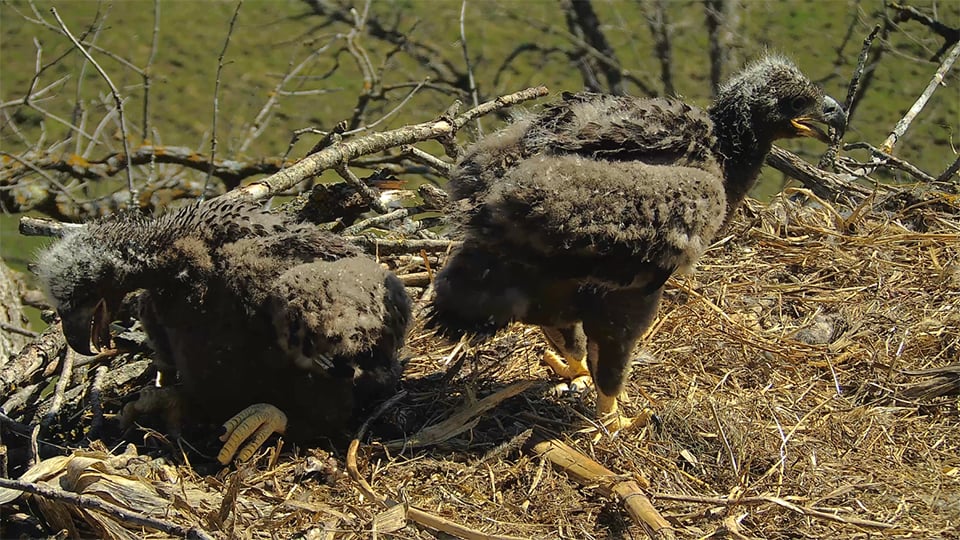 April 24, 2024: Look, Ma – no wings! DN18 and DN17 are learning their way around their huge feet and new’ish legs.
April 24, 2024: Look, Ma – no wings! DN18 and DN17 are learning their way around their huge feet and new’ish legs.
April 24, 2024: Synchronized looking – https://youtu.be/OOibBMWMY3M?si=4WjVPQeizm_5Br1D. DN17 and DN18 see something outside the nest. What has their attention? We don’t know, but I love to see them beginning to look around at the larger world.
Listen in the background and you’ll hear the sounds that make up the eagles’ world right now: Red-winged Blackbirds, Northern Cardinals, American Robins, Canada Geese, Mourning Doves, a Yellow-bellied Sapsucker, and woodpeckers drumming. The great tide of migration is sweeping in and their sensory world is alive with new sights and sounds!
April 23, 2024: Ultra-close-ups, clown clompers – https://youtu.be/oD7cm80PF0w?si=by2Jj67ZhAeaZ-sH. The camera operator zooms in for a close look at yellow clown clompers, dark talons, and emerging feathers as the eaglets sprawl in the nest, perhaps snoozing away their latest meal. Listen for a song sparrow in the background.
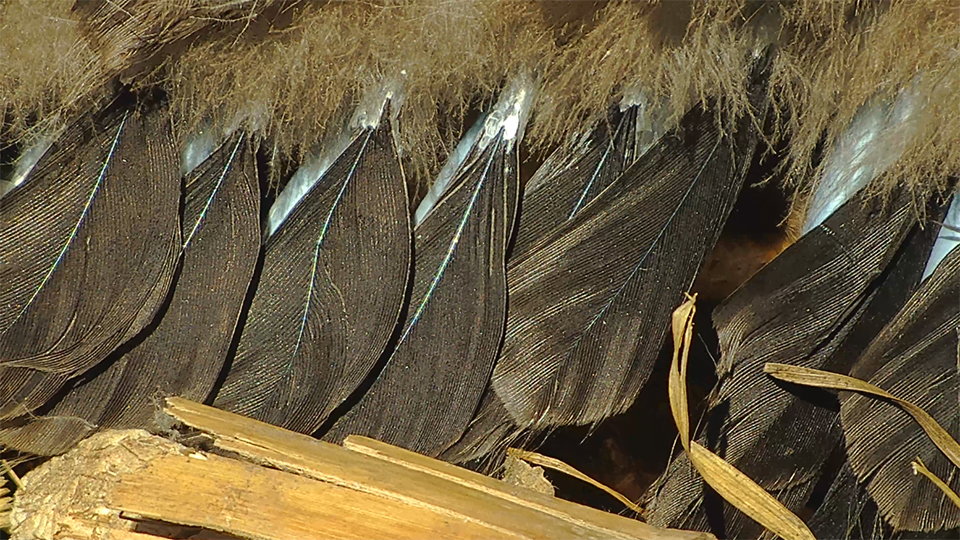 April 24, 2024: A very close look at pinfeathers emerging from keratin sheaths. Pinfeathers need blood while they are growing. The sheaths protect them from damage and breaking as they emerge.
April 24, 2024: A very close look at pinfeathers emerging from keratin sheaths. Pinfeathers need blood while they are growing. The sheaths protect them from damage and breaking as they emerge.
April 22, 2024: Sandhill Cranes mating in the early morning light – https://youtu.be/v8frYwJvT8k?si=3zO0C_f2bCDwg0E_. If you have ever wondered how sandhill cranes mate, look no further! Go to about 50 seconds to see a white-tailed deer wander through behind them. No privacy in the wild!
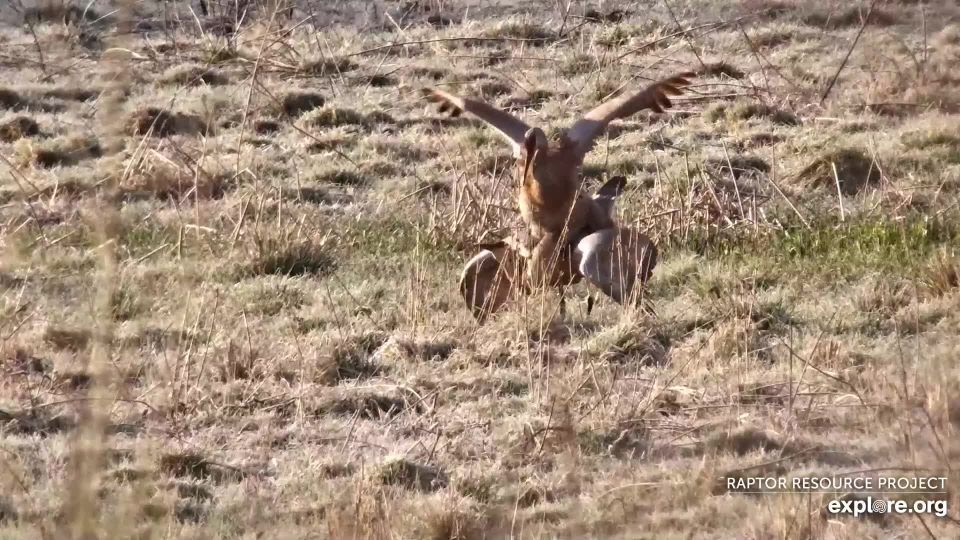 April 22, 2024: Sandhill Cranes mating near the North nest.
April 22, 2024: Sandhill Cranes mating near the North nest.
Like Bald Eagles and Peregrine Falcons, Sandhill Cranes were once common inhabitants of Iowa. But they were relentlessly hunted for food and feathers, pressured by wetland destruction, and plagued by the growing popularity of wild bird egg collections. The state’s last known nesting of sandhill cranes occurred in May of 1894 on a marsh located near Hancock County’s Eagle Lake. This final nesting attempt was unsuccessful when egg collectors looted the nest.
Sandhill cranes managed to hang on in Wisconsin, Minnesota, and Michigan, and laws were passed to protect them and to clean up their habitat. In 1992, breeding sandhill cranes returned to Iowa when two successful nests were documented at Tama County’s Otter Creek Wildlife Area. As of 2022, they had been documented nesting in 40 counties and had been spotted in another 49. We don’t know that they are nesting here – it’s open, which they like, but perhaps a little drier than they usually care for. Sandhill Cranes establish and maintain bonds away from their breeding grounds. Another couple of weeks should tell us whether they plan to stay or were just passing through.
April 20, 2024: Down the hatch! https://youtu.be/fapGZZBXJ-4?si=XVTGTFFNUZyuanJe. DN18 must have the munchies! Mr. North brought in some bedding and was digging in the nest when he found an opossum’s mandible (jaw). He pulled it out and offered it before changing his mind and placing it back in the straw. DN18, who was watching intently, uncovered it as soon as he left and swallowed it right down (check out the crop action). You would think the peaglet hadn’t already eaten five times that day!
Opossums have 50 sharp teeth in their mouths, which is more teeth than any other mammal in the U.S. They are not aggressive and their are omnivores that tend to consume food smaller than they are, at least if it is living. Why all the teeth? We’re not sure, but their threat display – gaping their mouth open, hissing, and showing off their teeth – is quite impressive!
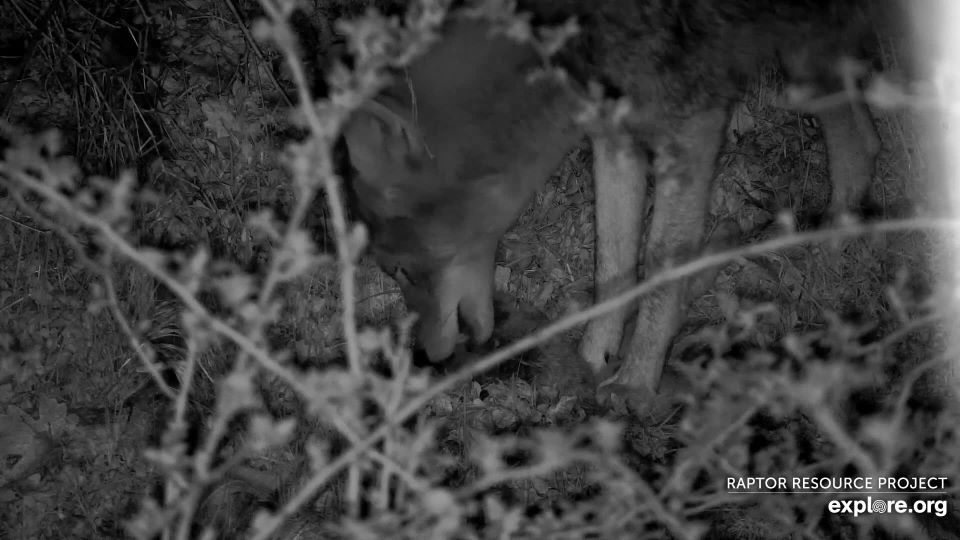 April 24, 2024: A coyote feasting on a mammal – opossum, perhaps? – near the North nest. I’ve wondered to what degree the coyotes and eagles end up feasting on each others leftovers!
April 24, 2024: A coyote feasting on a mammal – opossum, perhaps? – near the North nest. I’ve wondered to what degree the coyotes and eagles end up feasting on each others leftovers!
Mississippi Flyway
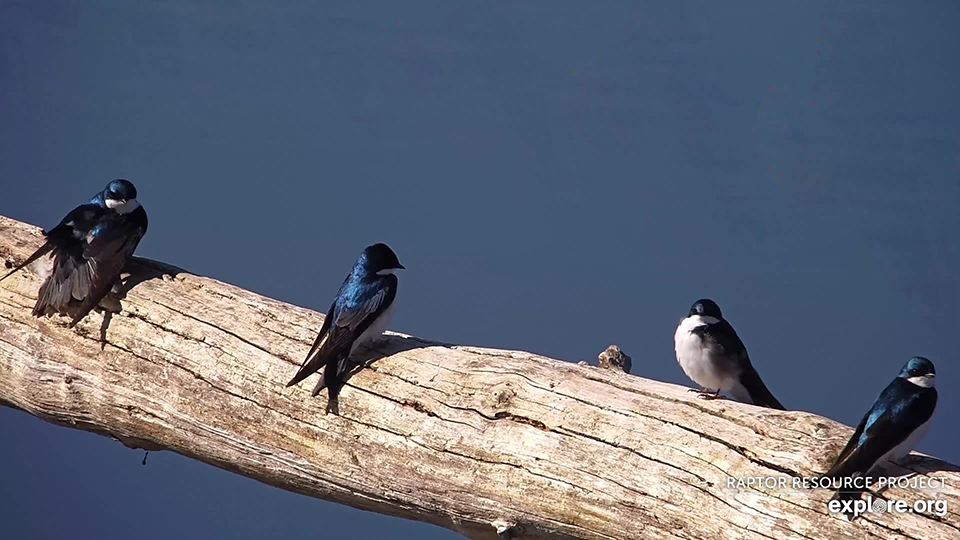 April 24, 2024: Tree Swallows on the Flyway.
April 24, 2024: Tree Swallows on the Flyway.
April 24, 2024: Tree Swallows on the fallen tree – https://youtu.be/RoeNbEKEFxY?si=_UexCwKaYPj1amOS. Little, mighty, and absolutely beautiful! Their shape and flight skills – look at those long wings! – make me think of peregrine falcons and I love their iridescent plumage. What a treat!
It’s getting ducky on the Flyway! https://explore.org/snapshots/mississippi-river-flyway-cam/.
Odds and Ends
What makes animals happy? https://bit.ly/3JAav9o. A fascinating long read by The New York Times (gift link). “One way to think about (animal welfare) reasoning is through the lens of “the five freedoms,” a rubric that animal-welfare thinkers have long embraced to consider all the different obligations that humans have to the animals in their care. They are: 1. the freedom from hunger and thirst; 2. the freedom from discomfort; 3. the freedom from pain, injury or disease; 4. the freedom to express normal behavior; and 5. the freedom from fear and distress.
It can be tough to balance our desire to help animals with their own needs and desires, which (like ours) can be in opposition to one another. What if the freedom to express normal behavior also means encountering hunger and thirst? How would an eagle or any other wild animal value the safety of captive care over the freedom to express normal behavior? And what does normal behavior mean when a bird’s normal behavior – flight – is something it can no longer do? This article has plenty of food for thought.
Do animals have fun? https://archive.ph/gnYo8. ‘Scientists want an evolutionary explanation for animal play. But maybe the answer is simply: It brings them joy.’ I’ll be ordering and reviewing this book for sure!
 The Raptor Resource Project
The Raptor Resource Project The Raptor Resource Project
The Raptor Resource Project